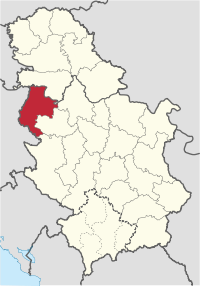Okrug Mačva
| Мачвански округ Mačvanski Okrug |
|
|---|---|
| State : | Serbia |
| Area : | 3,268 km² |
| Residents : | 339,644 (2002) |
| Capital : | Sabac |
| ISO 3166-2 : | RS-08 |
Mačva ( Serbian Мачвански округ or Mačvanski okrug ) is a Serbian administrative district and lies in the northwest of the Serbian heartland.
It consists of the following municipalities ( opštine ):
According to the 2002 census, this district has a population of 339,644. The main administrative seat is the city of Šabac .
Largest settlements (as of: 2002 census)
| Place name | Cyrillic | Residents |
|---|---|---|
| Sabac | Шабац | 54,832 |
| Loznica | Лозница | 26,203 |
| Lozničko Polje | Лозничко Поље | 7,668 |
| Bogatić | Богатић | 7,346 |
| Klupci | Клупци | 7.177 |
| Majur | Мајур | 6,768 |
| Banja Koviljača | Бања Ковиљача | 6,274 |
| Pocerski Pričinović | Поцерски Причиновић | 5,991 |
| Badovinci | Бадовинци | 5,413 |
| Krupanj | Крупањ | 4,875 |
| Mali Zvornik | Мали Зворник | 4,740 |
| Lešnica | Лешница | 4,677 |
| Koceljeva | Коцељева | 4,614 |
| Prnjavor | Прњавор | 4,488 |
| Lyubovija | Љубовија | 4.116 |
In the vicinity of Šabac there are many monuments dedicated to the historical events of the Serbian people:
- Monument to Karađorđe and other Serbian heroes of the first Serbian uprising
- Museum of the Battle of Mišar
- Remains of old towns on the Sava :
- Novo Selo (King Milutin's Castle)
- Košanin Grad (castle on the nearby mountain)
Not far from Loznica is the village Tršić , the birthplace of the Serbian philologist and creator of the modern Serbian written language, Vuk Stefanović Karadžić .
A footpath leads from Tršić to the Tronosa Monastery , one of the oldest structures of the Nemanjić dynasty . This 14th century monastery played an important role during the Ottoman Empire in the preservation and continuation of Serbian culture, as many historical documents and writings were hidden in the monastery at the time and repeatedly restored over the centuries .
The economic activity in the region is concentrated in the chemical factory “Zorka”, the meat factory “Šapčanka”, the furniture factory “Jela” and the metal and plastic factory “Metaloplastika”.
history
There is evidence that the Mačva region has been inhabited since the Stone Age. During the Roman Empire , the province of Moesia was located there . Old writings were also found in which the town of Mačva was mentioned, but the location of this town is still unclear today. It is believed to be a few kilometers south of Šabac.
In the Middle Ages, the Mačva region belonged to Serbia , Hungary , Bulgaria and Byzantium . Mainly it was fought between Serbia and Hungary. In the 13th century, the Mačva region was part of the Kingdom of Hungary under Béla IV. Between 1282 and 1316 Mačva was part of the Kingdom of Syrmia under the Serbian King Stefan Dragutin with the capital Debrc (between Belgrade and Šabac). In the 15th century the region came under the domination of the Ottomans and remained so into the 19th century. In 1804 Mačva became Serbian again.
The painter Milić Stanković, known as "Milić von Mačva", comes from the region.

